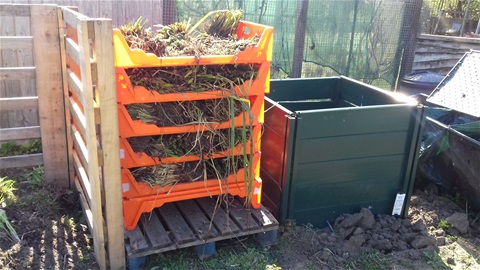Composting Perennial weeds
Composting Perennial Weeds
We are often advised that as perennial weeds will survive home composting using cold composting techniques, they should not be composted at home but put in the “Green” bin to be collected by the Council as part of their kerbside collections. This will mean that the weeds are hot composted by the council and can then be purchased back by the home gardener as part of commercially available composts.
However, in most cases there are two simple relatively quick options available to the home composter faced with perennial weeds involving pre-treated to make them safe to be cold composted. These options include drowning and desiccation. Both of these techniques can be seen at the Leicester Stokes Wood Allotment Composting site.
Drowning
Drowning is one of the quickest ways of dealing with perennial weeds and it has the advantage of producing a compost activator that can be added to the compost bin or used as a liquid plant food.
The perennial weeds are put into a lidded bucket, old Bokashi bin or water butt depending on the quantity involved and weighed down with a brick or stone. The weeds are covered with water, the lid put in place to exclude light and the soup left for four weeks. The liquid is then strained off to be used diluted and used as a plant food (see Plant Liquid Feeds) with the sludge being added to the compost bin or the complete contents of the bucket can be added to the compost bin.
Drying
This method requires a hot sunny summer to work most effectively. Spread the perennial weeds, or their roots, on a dry flat surface such as a concrete paving slab in full sun. To be on the safe side, if there are not too many of them, I like to smash and flatten them with a club hammer at this stage to assist the drying process. Once smashed they can be left on the concrete slab, moved to dry on a wooden cover on the top of the compost bin if a New Zealand or pallet bin is being used or dried on a rack made of discarded plastic bread crates (see photo). After two or three weeks in hot sunny weather the roots will be sufficiently baked to be safely added to the compost bin. If damp and dry the time should be extended.
More techniques are given on the www.carryoncomposting.com perennial weed page

Latest comments
Do you have any data on ' application ' of Aerated Vermi Compost Tea to Mangoes and benneficial outcomes .
Very informative site. Having been away for 5 weeks and returning to evidence of rats under and around the compost bin, I can testify to lack of human activity allowing the rats to get comfortable.
can i use dog manure in compost and mulching leaves?
What is the C and N ratio for coffee chaff?